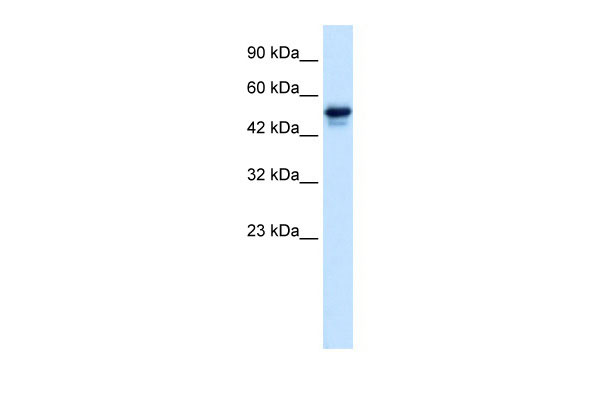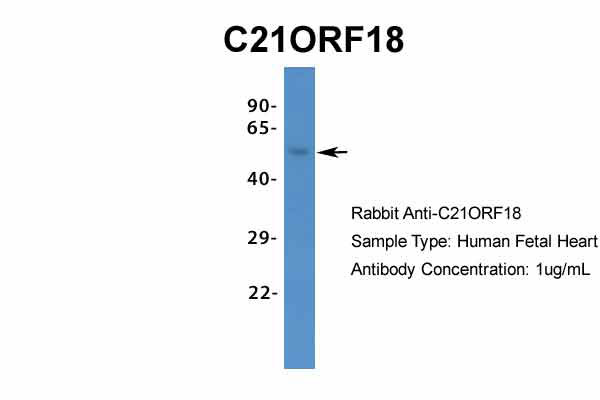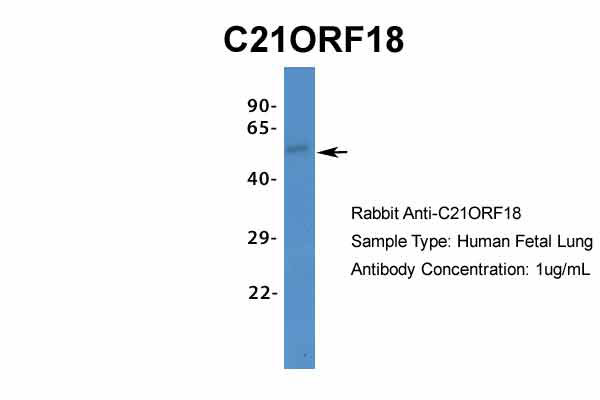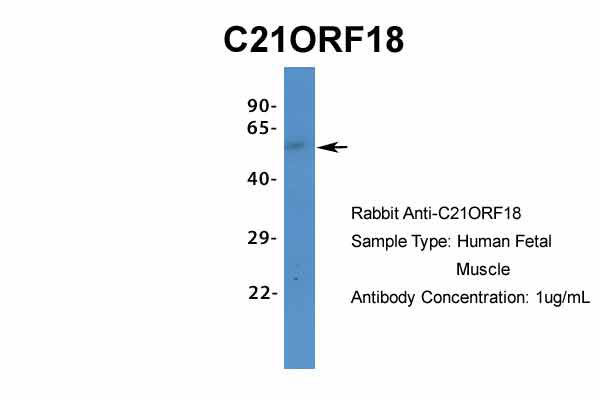C21ORF18 antibody - C-terminal region
Rabbit Polyclonal Antibody
- SPECIFICATION
- CITATIONS
- PROTOCOLS
- BACKGROUND

Application
| WB |
|---|---|
| Primary Accession | Q9NVD3 |
| Other Accession | NM_017438, NP_059134 |
| Reactivity | Human, Mouse, Rat, Rabbit, Horse, Bovine, Dog |
| Predicted | Human, Mouse, Bovine |
| Host | Rabbit |
| Clonality | Polyclonal |
| Calculated MW | 50kDa |
| Gene ID | 54093 |
|---|---|
| Alias Symbol | C21orf18, C21orf27 |
| Other Names | SET domain-containing protein 4, 2.1.1.-, SETD4, C21orf18, C21orf27 |
| Format | Liquid. Purified antibody supplied in 1x PBS buffer with 0.09% (w/v) sodium azide and 2% sucrose. |
| Reconstitution & Storage | Add 50 ul of distilled water. Final anti-C21ORF18 antibody concentration is 1 mg/ml in PBS buffer with 2% sucrose. For longer periods of storage, store at 20°C. Avoid repeat freeze-thaw cycles. |
| Precautions | C21ORF18 antibody - C-terminal region is for research use only and not for use in diagnostic or therapeutic procedures. |
| Name | SETD4 {ECO:0000303|PubMed:24738023, ECO:0000312|HGNC:HGNC:1258} |
|---|---|
| Function | Protein-lysine N-methyltransferase that methylates both histones and non-histone proteins (PubMed:31308046, PubMed:35545041, PubMed:37926288). Via its catalytic activity, regulates many processes, including cell proliferation, cell differentiation, inflammatory response and apoptosis. Regulates the inflammatory response by mediating mono- and dimethylation of 'Lys-4' of histone H3 (H3K4me1 and H3K4me2, respectively), leading to activate the transcription of pro- inflammatory cytokines IL6 and TNF-alpha (By similarity). Through the catalysis of TBK1 monomethylation, may regulate virus-induced interferon signaling. TBK1 monomethylation enhances its interaction with MAVS, STING and IRF3, hence promoting antiviral interferon signaling (PubMed:37926288). Also involved in the regulation of stem cell quiescence by catalyzing the trimethylation of 'Lys-20' of histone H4 (H4K20me3), thereby promoting heterochromatin formation (PubMed:31308046). In the brain, epigenetically controls quiescence of neural stem cells for sustaining a protected neural stem cell population and maintaining a stem cell reservoir for neurogenesis (By similarity). Involved in proliferation, migration, paracrine and myogenic differentiation of bone marrow mesenchymal stem cells (BMSCs) (By similarity). Through the catalysis of XRCC5/Ku70 trimethylation, regulates BAX-mediated apoptosis. SETD4-catalyzed XRCC5 methylation results in XRCC5 translocation to the cytoplasm, where it interacts with BAX, sequestering it from the mitochondria, hence preventing BAX- mediated apoptosis (PubMed:35545041). |
| Cellular Location | Cytoplasm, cytosol. Nucleus |

Thousands of laboratories across the world have published research that depended on the performance of antibodies from Abcepta to advance their research. Check out links to articles that cite our products in major peer-reviewed journals, organized by research category.
info@abcepta.com, and receive a free "I Love Antibodies" mug.
Provided below are standard protocols that you may find useful for product applications.
References
Reymond,A., et al., (2001) Genomics 78 (1-2), 46-54Reconstitution and Storage:For short term use, store at 2-8C up to 1 week. For long term storage, store at -20C in small aliquots to prevent freeze-thaw cycles.
If you have used an Abcepta product and would like to share how it has performed, please click on the "Submit Review" button and provide the requested information. Our staff will examine and post your review and contact you if needed.
If you have any additional inquiries please email technical services at tech@abcepta.com.













 Foundational characteristics of cancer include proliferation, angiogenesis, migration, evasion of apoptosis, and cellular immortality. Find key markers for these cellular processes and antibodies to detect them.
Foundational characteristics of cancer include proliferation, angiogenesis, migration, evasion of apoptosis, and cellular immortality. Find key markers for these cellular processes and antibodies to detect them. The SUMOplot™ Analysis Program predicts and scores sumoylation sites in your protein. SUMOylation is a post-translational modification involved in various cellular processes, such as nuclear-cytosolic transport, transcriptional regulation, apoptosis, protein stability, response to stress, and progression through the cell cycle.
The SUMOplot™ Analysis Program predicts and scores sumoylation sites in your protein. SUMOylation is a post-translational modification involved in various cellular processes, such as nuclear-cytosolic transport, transcriptional regulation, apoptosis, protein stability, response to stress, and progression through the cell cycle. The Autophagy Receptor Motif Plotter predicts and scores autophagy receptor binding sites in your protein. Identifying proteins connected to this pathway is critical to understanding the role of autophagy in physiological as well as pathological processes such as development, differentiation, neurodegenerative diseases, stress, infection, and cancer.
The Autophagy Receptor Motif Plotter predicts and scores autophagy receptor binding sites in your protein. Identifying proteins connected to this pathway is critical to understanding the role of autophagy in physiological as well as pathological processes such as development, differentiation, neurodegenerative diseases, stress, infection, and cancer.





